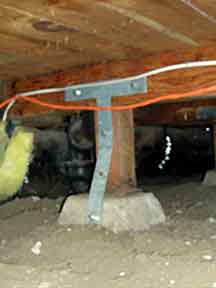MASSDRIVER
REGISTERED
.
^
The point. You missed it.
I see from your profile you are inspector. What I am asking is this; You visit my job to look at underpinning and floor framing. legitimately, and to code, I have wetset my piers, set and toenailed the 4X4 post to the block, then to plans and to code used a metal saddle to connect the post to a 4 X girder, on which set the joists. Now we know the post is connected to prevent uplift and lateral movement.
But the weak link in the chain is in 2 places. The pier to concrete interface, and the block to pier interface.
You know how I remove old pier blocks for remodels? I just take an 8 pound sledge and give it one good smack, and it comes loose, like 90% of the time. To remove an old block from the pier you just swing your hammer claw under it and pop it off the pier, because its usually just a nail or two holding it from underneath.
But try to remove one of those post connectors. They are the devil to move without practically destroying the thing.
Why be anal about the framing connector and protecting against uplift and lateral movement if you don't carry it all the way to through the system? What criteria do you use to insure the block is wetset properly? Is it one, two, or three inch slump? What if my concrete is almost dry and I just plop it on top of the footing?
Brent.
^
The point. You missed it.
I see from your profile you are inspector. What I am asking is this; You visit my job to look at underpinning and floor framing. legitimately, and to code, I have wetset my piers, set and toenailed the 4X4 post to the block, then to plans and to code used a metal saddle to connect the post to a 4 X girder, on which set the joists. Now we know the post is connected to prevent uplift and lateral movement.
But the weak link in the chain is in 2 places. The pier to concrete interface, and the block to pier interface.
You know how I remove old pier blocks for remodels? I just take an 8 pound sledge and give it one good smack, and it comes loose, like 90% of the time. To remove an old block from the pier you just swing your hammer claw under it and pop it off the pier, because its usually just a nail or two holding it from underneath.
But try to remove one of those post connectors. They are the devil to move without practically destroying the thing.
Why be anal about the framing connector and protecting against uplift and lateral movement if you don't carry it all the way to through the system? What criteria do you use to insure the block is wetset properly? Is it one, two, or three inch slump? What if my concrete is almost dry and I just plop it on top of the footing?
Brent.


